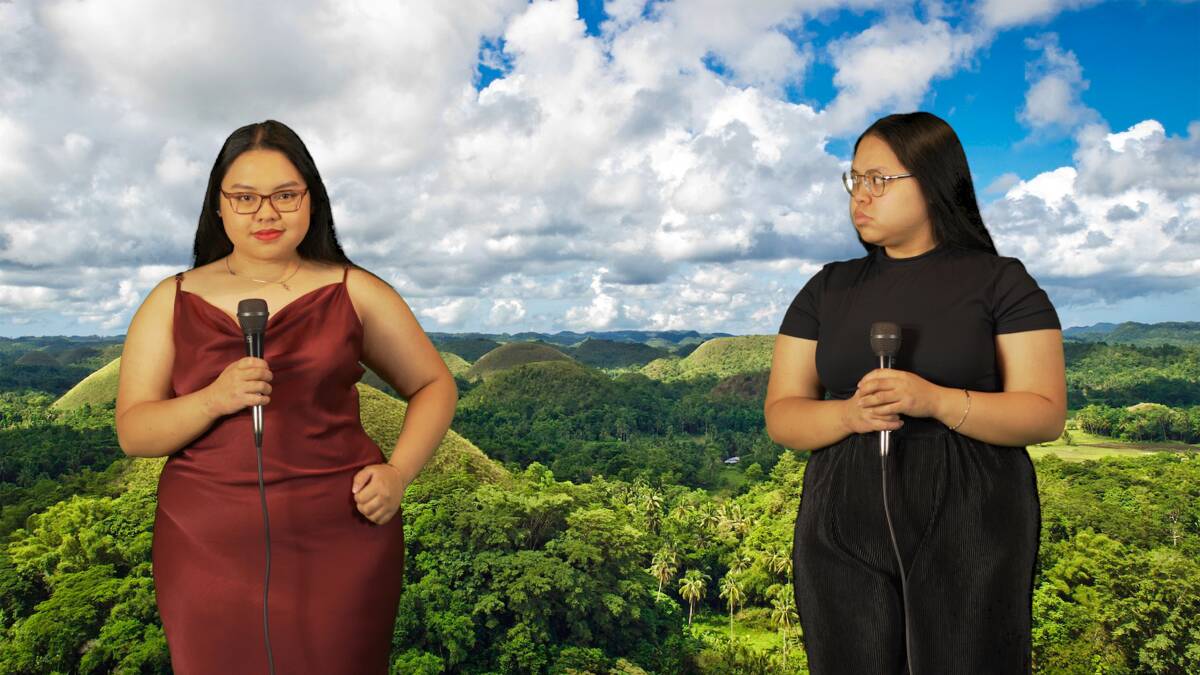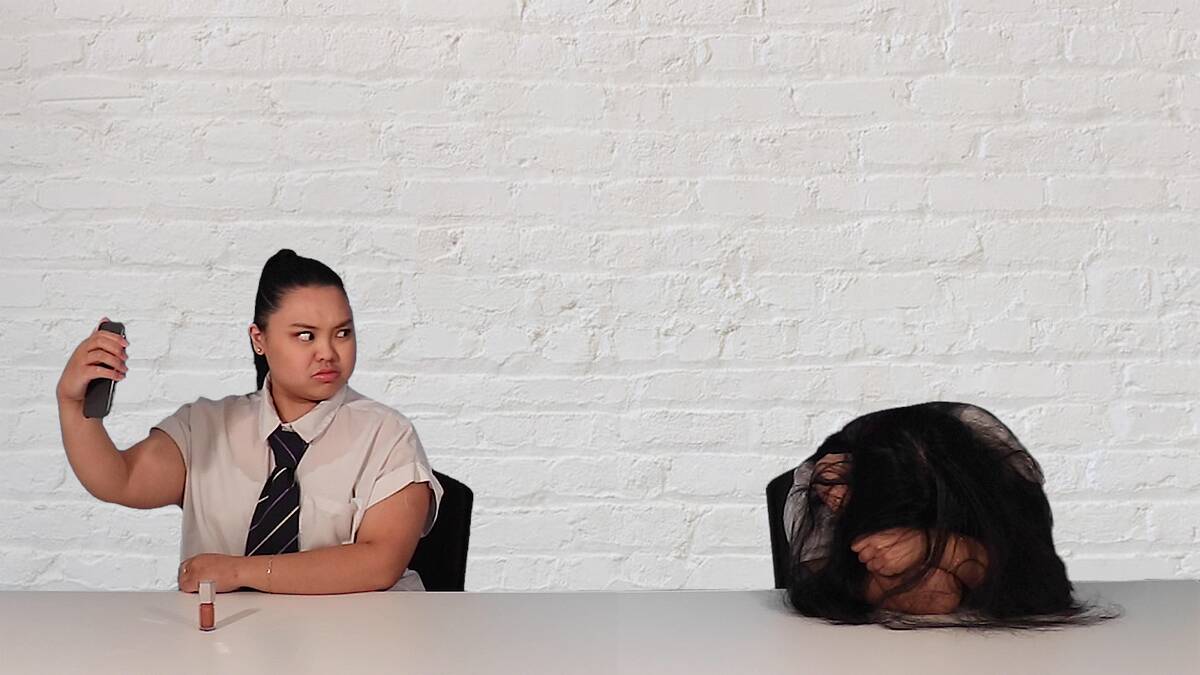
Being part of a culture should bring a sense of belonging but being a part of a diaspora means feeling like you're constantly living in two worlds and belonging to neither, muses Canberra-based artist Alexa Malizon.
Subscribe now for unlimited access.
$0/
(min cost $0)
or signup to continue reading
This is the backbone of Malizon's work, which shows at the Tuggeranong Arts Centre in her first solo exhibition, Diversitea Talks. As a Filipino woman born in Australia, her work reflects her own personal struggles with identity, growing up as a person of colour in a predominantly Anglo-Saxon Australia. This is one of many examples of the experience of diaspora, which refers to the contemporary phenomenon of cultural and ethnic dispersal that often comes with immigration - essentially it is when you were born or have moved to a country where your ethnicity does not originate in that geographical place.
Malizon associates her childhood with an unspoken yearning to assimilate - she felt the need to adopt Australian slang and play Australian sports at school, and when she turned the television on, the people she saw were white. "In the rare instance I saw someone Asian, it was always tokenistic and played to stereotypes," Malizon says.
A 2020 media study by Media Diversity Australia found that more than 24 per cent of the Australian population are of non-European descent, but that only six per cent of reporters and presenters in Australian television and radio identify with that ancestry. In her early years, Malizon quickly realised there was a huge lack of representation of Asian people, and people of colour in general, in Australian mainstream media.
"Since there is such an absence of ethnic minorities in popular culture, I wanted to represent a body that doesn't exist within the standards of both cultures, and for people to be exposed to it through my works," Malizon explains. She remembers that growing up, her skin colour and ethnic appearance brought complications to her sense of identity, but other aspects such as her size made her stand out too. Because she did not conform in appearance to either culture's standards, the experience added another layer of feeling "other".
Pop culture, such as social media and television, is often looked down upon in the art world, in comparison to the "serious" art displayed in state galleries, but it defines an entire nation's identity through the scale of its coverage. When ethnic minorities are absent in mass media and pop culture, however, racial stereotypes prevail, fuelled by prejudice and the lack of genuine experiences with that specific group. Australia, which prides itself on its diversity and multiculturalism, still has a culture of excluding the voices of people of colour from its mainstream discourse.

"This was the inspiration for my project," Malizon says. "The title Diversitea Talks talks about diversity, or rather the lack thereof, and 'spills the tea' on growing up in a Western-dominated world."
Malizon's recent video works stemmed from her asking herself how the photographic medium could be used to explore cultural difference. The result is a series of experimental videos that focus on post-production techniques such as video-layering, cropping and karaoke-esque subtitling. Through the five works exhibited in Diversitea Talks, Malizon brings the audience along with her on an emotional rollercoaster that traipses through a gradient of everyday experiences, such as starting at a new school and singing a karaoke duet. This journey, however, is punctuated with second-hand embarrassment and humour, and reveals the reality of second-generation immigrants.
This dissonance is furthered in Ningning (2020), where Malizon plays two characters who perform a duet of the classic Filipino pop song, Bituing Walang Ningning. On one side, a version of the artist with a full face of make-up wearing a silk gown appears to sing every lyric of the song perfectly, with grace and poise. Beside her, another version slouches shyly, mispronouncing the Tagalog lyrics and singing off tune.
The two eventually trail off into silence, staring at each other awkwardly. On the first character's face is disgust and disappointment; on the second it is shame. There is no reconciliation to this conflict within herself between her two identities; to be a second-generation immigrant means to belong to neither your ethnicity nor your nationality.
"Filipinas are expected to be graceful and talented," Malizon explains, "I don't fulfil that expectation, and I can't even speak Tagalog, but I don't fit into Australian expectations, either."
Filipinas are expected to be graceful and talented. I don't fulfil that expectation ... but I don't fit into Australian expectations, either.
"Shame is a control tactic for regulating behaviour," Malizon says - elements of both internal and external cultural shame are felt in the experience of displacement. To be a mixed body is to feel multiple levels of shame, from the shame of not being a conventionally Anglo-Saxon Australian person to the shame of not fitting into the strict archetype of the perfect Asian person. On top of that, there is an added shame when the diasporic person does not even fit into Western stereotypes of the tokenistic Asian portrayed in mainstream media.
This exploration of cultural expectations is explored in Mag Otso Otso (2020), where the artist performs a dance that went viral in the Philippines over a green-screened background of the music video of the pop hit Otso Otso. With each iteration of the chorus, the background video glitches multiply and overlay, creating dissonant echoes that overwhelm the audience.
"People understand art through their own experience," Malizon says, remembering the first time she showed the work to a colleague and was told that the dance looked like twerking.
Obviously, the original dance was not a reference to twerking, which was popularised in the past few years through Western pop culture, but in Mag Otso Otso, this interpretation adds another layer on what it means to be of Filipino descent and Australian nationality.
The exhibition, at its roots, creates a microcosmic projection of Australian diaspora, inhabiting that liminal intersection between binaries of self and other, here and there, belonging and isolation. At the heart of Malizon's practice is humour - she adopts a direct approach, refreshing in the contemporary Australian art scene dominated by subtle, symbolic abstractions. "With my work, I want a medium that is directly relatable to the audience," she says, explaining that Western mainstream and social media is dominated by short, witty and humorous videos - so there is no reason why this must be limited to the mobile phone and not extended to gallery spaces.
"Humour is powerful," Malizon explains, "because it has brought an understanding into the potential of resisting common cultural stereotypes while discussing the underlying issues of identity." In a way, the concept of humour is universal to all cultures - whether or not an individual truly understands what is being presented to them, if they are laughing, they have actively engaged with it. Through humour, Malizon captures the audience's attention, and asks them to reflect on what they are laughing at. Is it the exaggerated representation of the Asian stereotype that we have become so familiar with, or the awkward silence when the character who does not conform to that stereotype challenges it?
Alexa Malizon is navigating the in-between spaces that are often uncomfortable to talk about and as a result are often swept under the rug. The thing about diaspora, however, is that although it is easy to ignore from afar, when you are within that experience, it is all-encompassing and these difficult conversations become necessary. Malizon's work challenges the binaries of mainstream culture, revealing that important conversations take place in the infinite shades of grey between polarities of pure black and pure white.
"I hope my work will encourage other people to create works that explore and represent who they are," she says. "I hope other Filipinas and people of colour can see themselves in me." Working in the intersections between Filipino and Australian mainstream culture, Alexa Malizon is creating the art she wished she saw growing up.
- Diversitea Talks, by Alexa Malizon, is at Tuggeranong Arts Centre until December 16.

